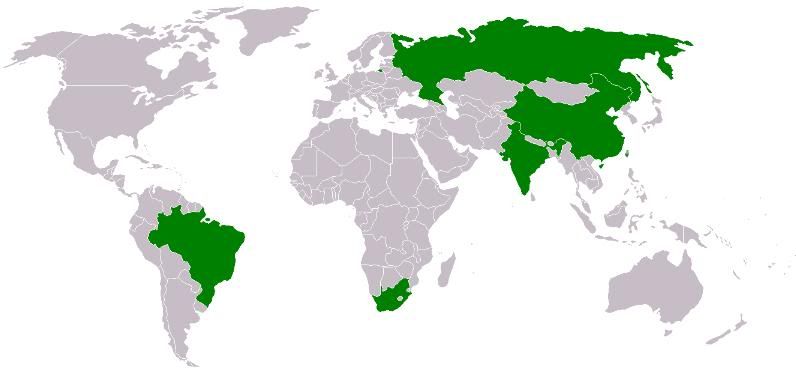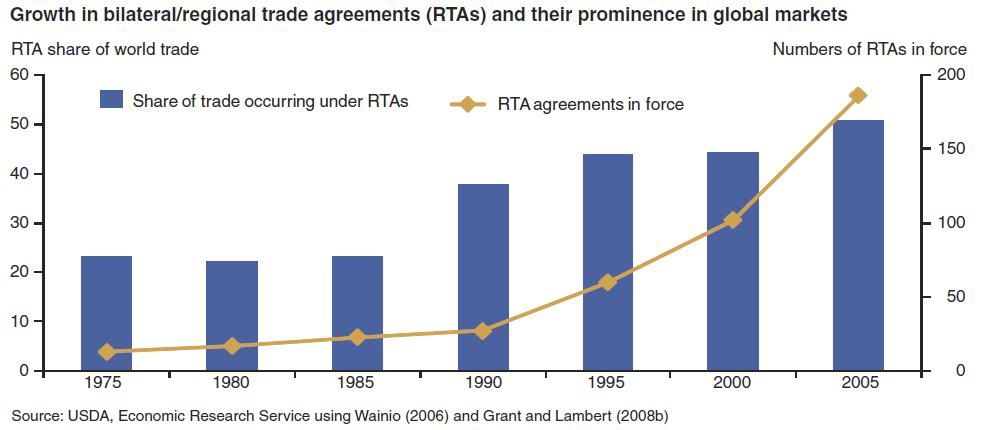
This week, the BRIC nations are meeting in China for their third annual summit. Brazil, Russia, India and China are now including South Africa. Already part of the G20, these nations are intent upon doing business with each other, lending to each other, and they are desirous of a new international reserve currency. All are feeling inflationary pressures and are concerned about excessive capital inflows from the developed nations and... all of this has huge future implications for the U.S.
Today's developed nations desperately need to produce and to export to help right over-indebted balance sheets. In other words, here in the U.S., we really need to gain back some of the manufacturing that we've outsourced and work to encourage exports. For more about agriculture's contribution to our trade imbalance, see my previous post, U.S. Agricultural Exports versus U.S. Trade Deficit.
When you consider that oil was one-fourth of our trade deficit in the year 2000 and now it is one-half, we seem to have an elephant in the room problem. So, while we desire more growth than the 2-3% expected these next few years - if we're lucky, we need to cut the use of oil if we are to improve our balance sheet. And reducing oil use while increasing productivity is an ambitious goal.
The dollar's value comes into play here, too, and looks like a no-win situation. If its value goes down we will increase exports but increase the price of our imported oil. If the dollar strengthens, the oil price goes down but we lose export market share.
As for America regaining globally outsourced jobs, expect more of this irony reported by the LA Times about IKEA, a green company based in Sweden, for treating U.S. workers poorly at its factory in Virginia:
"It's ironic that Ikea looks on the U.S. and Danville the way that most people in the U.S. look at Mexico," Street said.
The fact is, as we become more and more of a global economy there are "winners" and "losers". The playing field is leveling and is it any surprise that that would include worker wages and conditions?
The BRIC economies are stacked like this... The U.S. is the world's largest. China's is second largest. Brazil's economy is one-third the size of China's. The India and Russia economies are one-fourth the size of China's, and South Africa's is one-sixteenth. Russia and Brazil export commodities and China imports them.
Another ongoing international economic development is that of reciprocal trade agreements. The USDA has a new report out expressing concern about the rise of their use and the resulting agricultural market distortions. It defines them whereas "members grant special advantages to each other by using preferential arrangements, free trade agreements, customs unions, and common markets, in which members agree to open their markets to each other’s exports by lowering trade barriers to increase market access and expand trade in foreign markets."
Though this USDA chart only goes through the year 2005, the non-linear trend of RTA use is evident:

According to the WTO’s Committee on Regional Trade Agreements (CRTA), as of July 31, 2010, there are a total of 474 bilateral/regional trade agreements in force (World Trade Organization, 2010).
From another USDA report about selected trade agreements:
Since 2001, the United States has concluded negotiations with 13 countries, resulting in 8 trade agreements (TAs). Three additional agreements have been negotiated but not yet ratified by Congress, as of March 2011. Other countries have become increasingly active in negotiating their own trade pacts. This proliferation of TAs between key U.S. trading partners and competitors may have raised concerns among U.S. exporters, whose share in established markets could be eroded by such deals. ... Korea, Colombia, and the 10 ASEAN (Association of Southeast Asian Nations) countries have been particularly aggressive in negotiating TAs.
Finally, to use a real life recent example, the WSJ reports on the latest China-Brazil economic ties, totaling $62.6 billion in recent years. These agreements have been strained but continue to work themselves out. China's demand has led Brazil's huge soybean export growth and China may begin importing pork from Brazil.
"Currently, Brazil-China trade mainly concentrates on raw materials like iron ore and soybeans, and that's not bad," Ms. Rousseff said Tuesday at a business forum with corporate leaders from both countries. "But more diversified trade is the only way to support long-term trade relations." The joint statement signed by Mr. Hu and Ms. Rousseff covered a wide spectrum of cooperation. China said it would encourage its companies to increase imports of value-added products from Brazil and promised to increase dialogue over animal and plant  quarantine and food safety, according to a report on the joint statement by the state-run Xinhua news agency. Brazilian pig farmers have long sought to export pork to China. ...
quarantine and food safety, according to a report on the joint statement by the state-run Xinhua news agency. Brazilian pig farmers have long sought to export pork to China. ...
The countries agreed to expand contact between financial institutions and between energy companies, including Brazilian state-owned Petroleo Brasileiro SA, or Petrobras. Brazil agreed to allow Chinese companies to bid for a planned high-speed rail project, which is expected to be built ahead of the 2014 soccer World Cup and 2016 Olympic Games, both of which will be hosted by Brazil.
 quarantine and food safety, according to a report on the joint statement by the state-run Xinhua news agency. Brazilian pig farmers have long sought to export pork to China. ...
quarantine and food safety, according to a report on the joint statement by the state-run Xinhua news agency. Brazilian pig farmers have long sought to export pork to China. ...The countries agreed to expand contact between financial institutions and between energy companies, including Brazilian state-owned Petroleo Brasileiro SA, or Petrobras. Brazil agreed to allow Chinese companies to bid for a planned high-speed rail project, which is expected to be built ahead of the 2014 soccer World Cup and 2016 Olympic Games, both of which will be hosted by Brazil.
With BRIC nations growing between 7-8% per year, as those nations form alliances, trade agreements, and secure oil supplies, is the U.S. being left in the dust? The sands and tides are shifting in the global marketplace.
K. McDonald